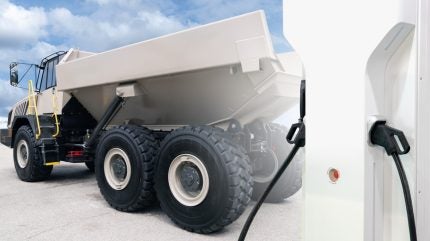
Much of the mining industry’s electrified future rests on advancements in charging technologies.
Developments in fast, dynamic and hybrid charging solutions are enabling battery electric vehicles (BEVs) to become an increasingly familiar sight in underground and surface mines. Mining Technology’s parent company, GlobalData, notes that there are almost 400 mining BEVs in operation globally as of the first quarter of 2025.

Discover B2B Marketing That Performs
Combine business intelligence and editorial excellence to reach engaged professionals across 36 leading media platforms.
To power these fleets, major miners are exploring innovative charging technologies for operational efficiency and reduced carbon emissions.
However, interoperability across vehicle types and charging infrastructure has yet to be achieved at scale. If charging solutions become standardised, fully electrified operations across the global mining industry can become a reality.
Fast and dynamic charging solutions
As mining vehicles transition away from diesel and become electrified, operational speed remains a priority for miners to meet or surpass production targets and avoid downtime of critical assets – a need that is met by fast charging.
Ben Ting, chief commercial officer of Echion Technologies, confirms that “the industry benchmark for fast charging is one hour out of a 24-hour day”. Echion is a spin-out of the University of Cambridge and supplies niobium-based anode materials with backing from strategic investor CBMM, the world’s biggest niobium miner.

US Tariffs are shifting - will you react or anticipate?
Don’t let policy changes catch you off guard. Stay proactive with real-time data and expert analysis.
By GlobalData
Research finds that fast charging, the most commonly used technology in underground mines, enables improvements in productivity by optimising the timing of charging periods, such as when workers are on shift breaks.
However, a flaw in the efficiency of fast charging technology is that BEVs typically remain stationery during the charging process.
“The ultra-class BEVs in mining have over a megawatt-hour (MWh) worth of batteries, and there is a lot of prep involved in charging them – parking the truck up, getting a big cable, safely connecting and disconnecting it,” explains Ting.
“All these things added up take too long within dynamic mine environments where it is important to keep moving all the time.”
Another common method is battery swapping, which is the exchange of a depleted battery for a fully charged one. However, this still requires dedicated stations and careful parking alignment.
This is where dynamic charging comes in, charging BEVs while they are in operation. This is typically achieved by attaching trucks to a catenary, the best of which can currently deliver 6–8MWh of power, according to Ting.
Charging efficiency also varies between BEV sizes. Hitachi Energy global transportation segment manager Bruce Warner previously told Mining Technology that charging technology is quite mature for smaller vehicles but for larger trucks will “take time and investment to bring it to a state where it can be widely used”, citing dynamic charging as a promising solution.
ABB global eMine mining solutions manager Nic Beutler tells Mining Technology that “while the capital costs can’t be ignored, they are becoming easier to justify.
“Modularity and scalability are overlooked benefits, as mines won’t have to overhaul everything at once. They can start small, prove the concept and scale incrementally as the fleet electrifies.”
Indeed, emerging charging solutions currently represent an upfront investment risk, but there are efforts to build out and standardise solutions for wholesale industry electrification.
Charging interoperability
A key barrier to increased industry adoption is a lack of interoperability between charging technologies, infrastructure and vehicle types.
The Charging Interface Initiative (CharIN) association, which promotes a combined charging system as a global standard for electric vehicles (EVs), has been collaborating with the International Council on Mining and Metals (ICMM) on this bottleneck.
“The result is a clear road map structured around three complementary technologies,” explains CharIN technical project manager Daniela Soler.
These are the Ruggedised Megawatt Charging System (R-MCS) for high-power static charging; the Dynamic Charging Interface (DCI), which supports charging while in motion; and the extreme Megawatt Charging System (X-MCS), aimed at ultra-fast original equipment manufacturer (OEM)-agnostic charging for large haul trucks.
With these advancements, CharIN is targeting “automation, durability and scalability”, but interoperability remains the top priority, says Soler. “Mining fleets are diverse, often with equipment from multiple OEMs, operating across different sites in different climates. If each OEM or site requires its own proprietary charging system, the cost, complexity and risk increase heavily.”
ICMM director of innovation Bryony Clear Hill adds that “standardisation supports the deployment of high-power chargers and dynamic energy transfer systems essential for large mining vehicles, especially in demanding environments.”
Digitalisation is another important piece. As Beutler highlights: “Right now, many charging systems are reactive – plug in, charge, then move on. What is needed is more intelligent infrastructure that is aware of fleet scheduling, power network loads and a mix in supply, even with renewable energy inputs.”
As more charging solutions, both digital and physical, become available to miners, there is a higher chance of oversaturation in the market. Ting maintains that “standardisation should come after experimentation. Despite the mining industry wanting high-level certainty, many different approaches should be tested to then zone in on what should be the standard.”
Industry activity in charging innovation
Alongside broader initiatives, major miners have been pursuing pilot projects and fast charging remains a popular avenue.
Ting highlights Australian mining giant Fortescue as a leader in this area. At the end of 2024, the company received an A$10m ($6.48m) grant from the Australian Renewable Energy Agency to develop 6MW fast chargers for heavy BEVs, building on its previous prototypes.
Across the Pacific in Canada, Newmont’s Borden gold mine is transitioning into the world’s first all-electric underground mine – a mission enabled by fast charging stations and power reticulation systems with additional power lines and a one kilovolt supply.
Hybrid solutions are also emerging, allowing miners to reap the combined benefits of fast and dynamic charging. Elonroad CEO Karin Ebbinghaus states that with better charging, “there is less need for big batteries, and so mining vehicles will become cheaper, as batteries are quite often the most expensive part of a vehicle”. The company offers dynamic charging stations for miners and estimates that industry electrification stands at only 0.5%.

Hybrid charging is “brand new for mining”, comments Ting. “There is a lot of interest in trials, particularly from the smaller miners, so that they can be second movers.”
In the meantime, major OEMs continue to push more charging solutions out into the market. Most recently, at MINExpo 2024, Caterpillar unveiled its Dynamic Energy Transfer system, which includes a power module, electrified rail system and a machine system to transfer energy to an operating truck.
Also at MINExpo 2024, Komatsu showcased its first battery-electric load haul dump truck with ground-level battery swap capabilities and its collaboration with ABB on the eMine™ Robot Automated Connection Device, which automatically connects and disconnects mining EVs to charging stations.
“It is a new way of thinking with new technologies, so tests in different environments are crucial,” says Ebbinghaus. “In a large ecosystem, the OEMs and power grid companies also need to be involved. It is about bringing new people together for discussion, which can be a challenge.”
Hill emphasises that “success in developing charging technologies hinges on collaboration between stakeholders to advance the electrification of mining”.
Charging the future of mining
Charging advancement in mining is on an upward trajectory, with Ting asserting that hybrid solutions in particular hold exceptional promise.
“Most mines will run on a hybrid system with onboard charging,” he says. “There is a real opportunity for greenfield sites in designing and planning the mine with charging infrastructure in mind from day one.”
Ebbinghaus concurs, urging stakeholders to continue building on the progress that has been made so far. “The industry has already spent a lot of funding on researching autonomous and electrified operations, and now it is time to combine them and focus on charging infrastructure.”
Of course, charging solutions are just one piece of the wider puzzle of mining electrification, and must develop alongside other clean energy mining solutions such as batteries and renewable power sources from on-site microgrids.
“Mines will increasingly rely on predictive charging schedules, energy-aware routing and coordination with renewable supply,” confirms Beutler.
Industry progress in charging could also serve as a blueprint for other sectors such as ports and heavy rail, as Soler points out.
CharIN expects R-MCS and DCI systems to be deployed in mines in the short term, with X-MCS on a longer time frame that could see it rival or even surpass diesel refuelling across different industries.
“Ultimately, charging will move from being a technical challenge to becoming a strategic advantage, one that enhances productivity, lowers emissions and future-proofs mining operations,” Soler concludes.





